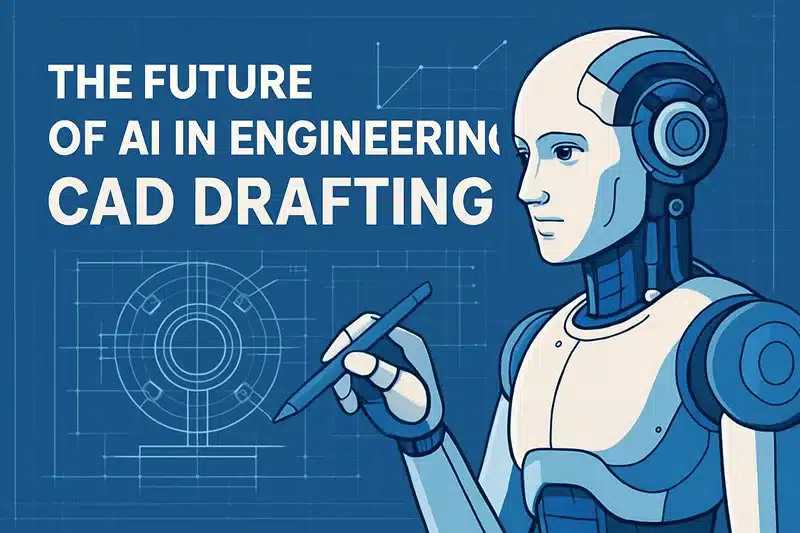The integration of Artificial Intelligence (AI) in engineering has revolutionized various disciplines, and one of the most promising applications lies in CAD (Computer-Aided Design) drafting. As industries continue to demand faster, smarter, and more accurate design processes, AI in engineering CAD drafting is emerging as a game-changer.
From automating repetitive tasks to offering intelligent design suggestions, AI is not just a tool but a transformational force that will shape the future of engineering drafting. This blog explores how AI is influencing engineering CAD drafting and what the future holds.
How AI is Changing Engineering CAD Drafting
1. Automating Repetitive Tasks
Traditionally, CAD drafters spend hours on manual tasks such as dimensioning, annotation, and creating standard components. AI-powered drafting tools now automate these repetitive steps, allowing engineers to focus on design innovation. AI algorithms can detect patterns and automatically apply standard conventions across multiple drawings.
2. Enhanced Error Detection
AI systems use predictive analytics and machine learning to scan designs for inconsistencies, errors, or clashes in real time. This proactive approach reduces design errors and ensures higher accuracy in project delivery, saving both time and money.
3. Generative Design Capabilities
Generative design is one of the most exciting aspects of AI in engineering. By inputting design constraints and goals, AI algorithms can generate multiple design alternatives that meet functional requirements. Engineers can evaluate and select the most efficient, cost-effective, and structurally sound options.
4. Improved Collaboration
Cloud-based AI tools allow seamless collaboration between engineers, architects, and other stakeholders. These platforms can automatically sync changes, highlight revisions, and provide real-time feedback, making the drafting process faster and more cohesive.
5. AI-Powered Design Recommendations
AI can analyze massive datasets from previous engineering projects and offer intelligent design suggestions. This capability helps in choosing better materials, optimizing structural integrity, and reducing unnecessary components.
Future Trends of AI in Engineering CAD Drafting
1. Natural Language Processing (NLP) Integration
AI tools will soon allow engineers to interact with CAD software using natural language. Instead of using complex commands, engineers might simply say, “Draw a 10-meter beam with 300mm thickness,” and the software will interpret and execute the command.
2. Voice and Gesture Recognition
With AI-driven voice and gesture recognition, engineers can work more interactively with their CAD environments. This will enhance productivity, especially in VR/AR-supported CAD systems where hands-free operation is beneficial.
3. Predictive Maintenance of Designs
AI can evaluate the lifespan and potential failure points of mechanical or structural components during the drafting phase. This predictive capability will help engineers design more durable and efficient systems.
4. Integration with BIM and Digital Twins
As Building Information Modeling (BIM) and Digital Twin technologies evolve, AI will play a vital role in integrating real-world data into CAD models, creating living digital models that can simulate and predict behavior throughout the lifecycle of a project.
Benefits of AI in Engineering CAD Drafting
- Time Efficiency: Speeds up the drafting process through automation.
- Accuracy: Minimizes human error with intelligent checking systems.
- Cost Savings: Reduces rework and material wastage through optimal design suggestions.
- Innovation: Enables generative design and smart simulations.
- User-Friendly Tools: Simplifies complex tasks for both beginners and professionals.
Challenges Ahead
While AI brings numerous benefits, it also presents challenges such as:
- Data Security: Cloud-based AI tools require robust cybersecurity measures.
- Learning Curve: Engineers and drafters need training to adapt to AI-integrated systems.
- Standardization: Lack of standard AI protocols across industries can hinder interoperability.
Preparing for an AI-Powered Future
Engineering firms must start investing in AI-based CAD tools and training programs to stay competitive. Encouraging cross-functional collaboration between AI developers and engineering professionals can also accelerate innovation and practical implementation.
By adopting AI in engineering CAD drafting today, companies can future-proof their workflows, enhance project outcomes, and maintain a competitive edge in the rapidly evolving digital landscape.
The future of engineering CAD drafting lies in embracing AI in engineering to drive smarter, faster, and more innovative design processes. While challenges exist, the potential benefits far outweigh the hurdles. As AI continues to mature, it will redefine what is possible in engineering design, making projects more efficient, cost-effective, and sustainable.
What is AI in Engineering CAD Drafting?
AI in engineering CAD drafting refers to the use of artificial intelligence technologies like machine learning, automation, and data analytics to enhance design accuracy, automate drafting tasks, and improve decision-making in engineering projects.
How does AI benefit CAD drafters?
AI assists CAD drafters by automating repetitive tasks, reducing errors, offering smart design suggestions, and enabling faster revisions, thus increasing efficiency and creativity.
Can AI replace human drafters?
No, AI is designed to assist, not replace. Human creativity, problem-solving, and engineering judgment remain irreplaceable. AI serves as a powerful tool to enhance productivity and quality.
What skills do engineers need to work with AI in CAD drafting?
Engineers should have a good understanding of CAD tools, basic knowledge of AI concepts, and adaptability to learn new AI-powered software features.
What is the future of AI in engineering?
The future of AI in engineering includes more intelligent design automation, integration with digital twin and IoT, real-time collaboration tools, and increased use of predictive analytics in drafting and modeling.
